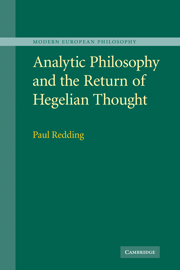Book contents
- Frontmatter
- Contents
- Acknowledgements
- Introduction: analytic philosophy and the fall and rise of the Kant–Hegel tradition
- 1 McDowell, Sellars and the myth of the perceptually given
- 2 Brandom, Sellars and the myth of the logical given
- 3 Individuation and determinate negation in Kant and Hegel
- 4 The Kantian route to Hegel's inferentialism
- 5 Aristotelian Phronesis and the perceptual discernment of value
- 6 Kant, Hegel and the dynamics of evaluative reason
- 7 Hegel and contradiction
- 8 Hegel, analytic philosophy and the question of metaphysics
- Bibliography
- Index
2 - Brandom, Sellars and the myth of the logical given
Published online by Cambridge University Press: 22 September 2009
- Frontmatter
- Contents
- Acknowledgements
- Introduction: analytic philosophy and the fall and rise of the Kant–Hegel tradition
- 1 McDowell, Sellars and the myth of the perceptually given
- 2 Brandom, Sellars and the myth of the logical given
- 3 Individuation and determinate negation in Kant and Hegel
- 4 The Kantian route to Hegel's inferentialism
- 5 Aristotelian Phronesis and the perceptual discernment of value
- 6 Kant, Hegel and the dynamics of evaluative reason
- 7 Hegel and contradiction
- 8 Hegel, analytic philosophy and the question of metaphysics
- Bibliography
- Index
Summary
In 1994, the year of the publication of Mind and World, another path-breaking work in analytic philosophy was published which was grounded in the work of Sellars and which signalled a radical realignment of analytic philosophy with respect to the idealist tradition. Again, Hegel was invoked as a thinker relevant for the resolution of deep problems within late twentieth-century analytic philosophy, but in Making It Explicit, Robert Brandom seemed to invoke quite different aspects of Hegelianism than had McDowell in Mind and World, and had drawn rather different consequences from Sellars's critique of the myth of the given.
Brandom describes the programme initiated in Making It Explicit as a post-Sellarsian ‘inferentialist’ alternative to the dominant ‘representationalist’ paradigm within modern philosophy, an alternative based upon a form of pragmatism that he describes as both rationalist and linguistic. Representationalists typically think of awareness in terms of mental contents that somehow represent or picture worldly things, events, or states of affairs. However, the representationalists’ picture, claims Brandom, is vitiated by its acceptance of the myth of the given. In contrast to representationism, the inferentialist approach to semantic content invokes Frege's ‘context principle’ as developed in mid-twentieth-century analytic philosophy in the generally pragmatic approaches to language found in Wittgenstein and Sellars. Following Frege, Wittgenstein had, in the Tractatus Logico-Philosophicus, regarded the proposition as the basic meaningful unit – ‘only in the nexus of a proposition has a name meaning’.
- Type
- Chapter
- Information
- Analytic Philosophy and the Return of Hegelian Thought , pp. 56 - 84Publisher: Cambridge University PressPrint publication year: 2007



